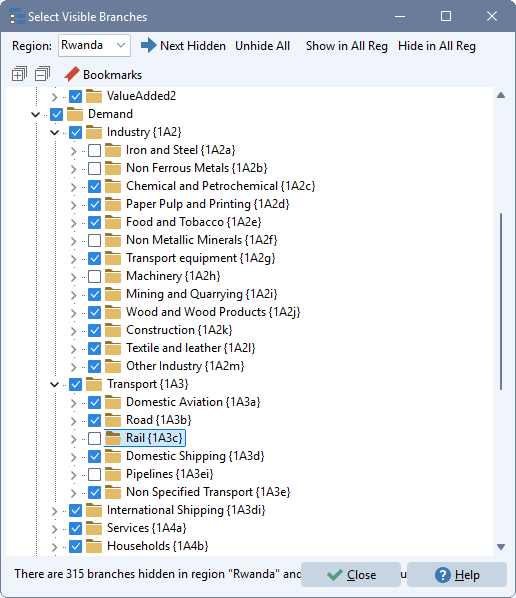Topic: Multi-Region Modeling and Other Questions Subscribe | Previous | Next
Sara Zaidan 7/28/2024
Hello,
I have several questions related to LEAP:
1. I have noticed while working on multiple regions that if I add or delete a branch from the tree in one area it directly reflects in another area. I know there is an "inherent expression from region" option to control data/expressions inherited to other regions. However, how can I control the tree structure? To be specific, the tree structure in area A is different than area B and I want this to reflect in the model. Is that possible?
2. Is there a place to define "capacity factor" when using the simulation mode in LEAP?
3. How do we define technology learning rates when using the simulation mode in LEAP?
4. Is it possible to consider/test out the impact of implementing "adaptation" measures (aside from mitigation measures as well) in LEAP?
Appreciate your support.
Hi Sara,
I will try to answer at least some of those questions!
>>I have noticed while working on multiple regions that if I add or delete a branch from the tree in one area it directly reflects in another area. I know there is an "inherent expression from region" option to control data/expressions inherited to other regions. However, how can I control the tree structure? To be specific, the tree structure in area A is different than area B and I want this to reflect in the model. Is that possible?
The tree structure is shared across all regions. However, you can selectively hide certain branches in certain regions. Use the show and hide buttons attached to the tree toolbar or use menu option Tree: Select Visible Branches (shown below) to select what branches are shown and calculated in each region.
>>Is there a place to define "capacity factor" when using the simulation mode in LEAP?
You can enter the maximum availability (which is essentially the maximum possible value of the capacity factor) for each process using the Maximum Availability variable. Bear in mind that this is a time-sliced variable so availability can vary by season, by time of day or even by type of day.
3. How do we define technology learning rates when using the simulation mode in LEAP?
If by "learning rate" you mean how a type of cost (capital, O&M) varies over time, then you can do this by specifying costs as dynamic variables that change over time. Those changes can be different in each scenario. If you mean that you want to make unit costs a function of cumulative installed capacity (as a proxy for experience with a technology) then you can create an expression that makes costs a function of the total cumulative installed capacity. Since capacity is a result variable, that function would need to make the unit cost a function of capacity lagged by one year. Note that this type of function is not currently possible in optimization modes since all capacities over time are calculated in a single multi-year optimization. Perhaps worth noting that these types of functions are generally more useful in global models. At the national scale (especially in smaller countries), the amount of cumulative installed capacity in the country may not be that important for determining the cost (especially if the country imports the technology).
4. Is it possible to consider/test out the impact of implementing "adaptation" measures (aside from mitigation measures as well) in LEAP?
Hmm - adaptation is such a broad concept! But, for example, if it includes scenarios that reflect more resilient energy systems or systems that reduce impacts on populations or that foster human development, then yes, certainly you could explore those using LEAP's scenario analysis features. For example, you can explore indoor and outdoor air pollution impacts that reduce deaths from air pollution while also addressing climate mitigation. In addition, we have started doing integrated energy and water resource planning by using LEAP in conjunction with its sister framework WEAP for water resource planning, to identify policies and plans that reduce energy system impacts while also addressing adaptation related challenges such as increasing water resources to better support human populations and the ecosystems they live in.
Hope this helps!


